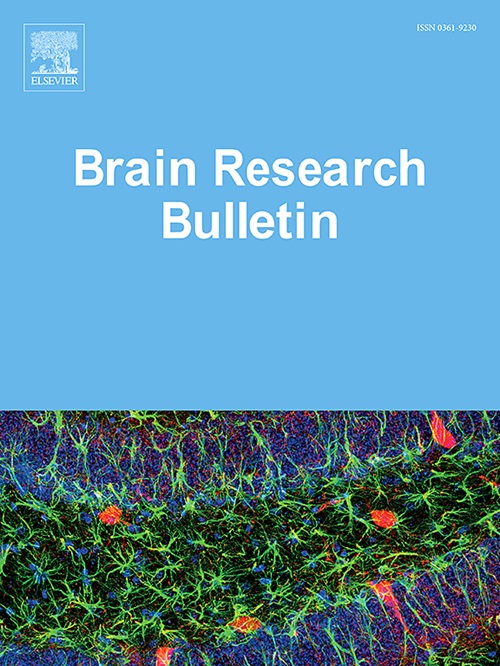白藜芦醇抗抑郁作用背后的tas2r123相关线粒体组织和神经可塑性。
IF 3.5
3区 医学
Q2 NEUROSCIENCES
引用次数: 0
摘要
背景:白藜芦醇是一种天然苦多酚,具有显著的抗抑郁作用。许多研究已经将其抗抑郁作用与神经可塑性增强或线粒体调节联系起来。然而,这两种机制之间的相互作用尚不清楚。本研究旨在阐明白藜芦醇的抗抑郁作用及其对神经可塑性和线粒体功能的调节作用,并探讨2型苦味受体(Tas2rs)在这些过程中的潜在作用。方法:采用慢性不可预测轻度应激(CUMS)模型诱导抑郁样行为,同时给予白藜芦醇干预。在CUMS和白藜芦醇治疗后,结合生物信息学的蛋白质组学分析预测了海马生物通路的显著改变。上述预测通过免疫印迹(WB)、高尔基染色、尼氏染色和电子显微镜进行验证。此外,使用定量PCR, WB和钙测定试剂盒定量Tas2rs表达和海马中钙(Ca2+)水平。最后,利用免疫荧光(IF)共定位检测Tas2r123与海马线粒体外膜的关联。结果:白藜芦醇可显著减轻CUMS所致的抑郁样行为。蛋白质组学分析显示,白藜芦醇的治疗作用与神经可塑性相关的代谢途径有关,特别是与主要定位于线粒体的差异表达蛋白(DEPs)有关。线粒体dep的基因本体论分析进一步揭示了线粒体组织的实质性变化。此外,分子生物学实验证实了这些蛋白质组学的发现。此外,白藜芦醇还逆转了cums诱导的Tas2r123 mRNA和蛋白表达的下调。此外,IF共定位表明Tas2r123与线粒体之间存在很强的关联。结论:我们的研究结果表明,白藜芦醇可能通过tas2r123 -线粒体组织途径调节神经可塑性,从而发挥抗抑郁作用。本研究提出了一种新的视角,将Tas2rs与白藜芦醇的抗抑郁机制联系起来,可能为未来的抗抑郁治疗铺平道路。本文章由计算机程序翻译,如有差异,请以英文原文为准。
Tas2r123-associated mitochondrial organization and neuroplasticity underlying the antidepressant effect of resveratrol
Background
Resveratrol, a natural bitter polyphenol, exhibits significant antidepressant property. Numerous studies have linked its antidepressant effect to neuroplasticity enhancement or mitochondrial regulation. However, the interplay between these two mechanisms remains unclear. This study aims to elucidate the relationship among resveratrol’s antidepressant effect, its regulatory impact on neuroplasticity and mitochondrial function, and to investigate the potential role of the type 2 bitter taste receptors (Tas2rs) in these processes.
Methods
A chronic unpredictable mild stress (CUMS) model was used to induce depressive-like behaviors, while resveratrol was administered as an intervention. Following CUMS and resveratrol treatment, proteomic analysis combined with bioinformatics predicted significantly altered biological pathways in the hippocampus. The aforementioned predictions were validated using Western blotting (WB), Golgi staining, Nissl staining, and electron microscopy. Additionally, Tas2rs expression and calcium (Ca2 +) levels in the hippocampus were quantified using quantitative PCR, WB, and calcium assay kit. Finally, immunofluorescence (IF) colocalization was used to examine the association of Tas2r123 with mitochondrial outer membrane in hippocampus.
Results
Resveratrol significantly alleviated depressive-like behaviors induced by CUMS. Proteomic analysis revealed that resveratrol’s therapeutic effects are associated with neuroplasticity-related and metabolic pathways, particularly with differentially expressed proteins (DEPs) predominantly localized in the mitochondria. Gene Ontology analysis of mitochondrial DEPs further revealed substantial changes in mitochondrial organization. Furthermore, molecular biology experiments validated these proteomics findings. Additionally, resveratrol also reversed the CUMS-induced downregulation of Tas2r123 mRNA and protein expression. Moreover, IF colocalization demonstrated a strong association between Tas2r123 and mitochondria.
Conclusions
Our findings suggest that resveratrol may exert antidepressant property by modulating neuroplasticity through the Tas2r123-mitochondrial organization pathway. This study introduces a novel perspective linking Tas2rs to resveratrol’s antidepressant mechanisms, potentially pave the way for future antidepressant therapies.
求助全文
通过发布文献求助,成功后即可免费获取论文全文。
去求助
来源期刊

Brain Research Bulletin
医学-神经科学
CiteScore
6.90
自引率
2.60%
发文量
253
审稿时长
67 days
期刊介绍:
The Brain Research Bulletin (BRB) aims to publish novel work that advances our knowledge of molecular and cellular mechanisms that underlie neural network properties associated with behavior, cognition and other brain functions during neurodevelopment and in the adult. Although clinical research is out of the Journal''s scope, the BRB also aims to publish translation research that provides insight into biological mechanisms and processes associated with neurodegeneration mechanisms, neurological diseases and neuropsychiatric disorders. The Journal is especially interested in research using novel methodologies, such as optogenetics, multielectrode array recordings and life imaging in wild-type and genetically-modified animal models, with the goal to advance our understanding of how neurons, glia and networks function in vivo.
 求助内容:
求助内容: 应助结果提醒方式:
应助结果提醒方式:


